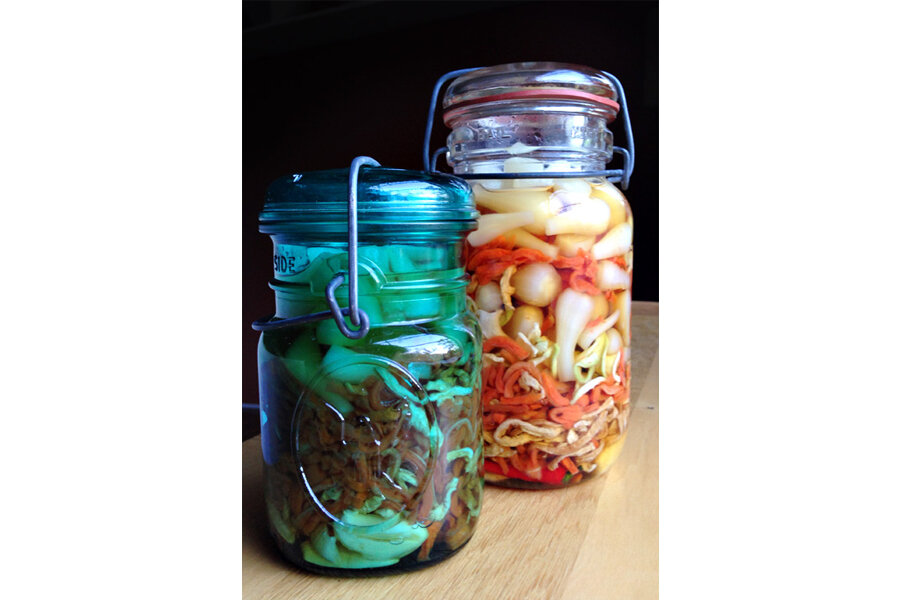'Dưa món,' Vietnamese brined vegetables
Loading...
Dưa món is a mix of brined vegetables, a Vietnamese version of an Italian giardiniera that is ubiquitously found on tables of feasting Vietnamese families during lunar new year celebrations. It’s commonly eaten with traditional banh chung and banh tet, but can really be used as a vegetable side for a meat entree. Each family may have their own recipes that vary slightly, but they all consist of carrot, daikon, and leeks brined in a prepared fish sauce.
Another common vegetable is green papaya but our aunt also loves throwing in boiled peanuts for some crunch. The vegetables in dua món have an extra crunchiness and bite that’s different from the regular do chua that’s used in banh mi or spring rolls. The secret is to start with dried vegetables, which after sitting in the fish sauce for a few days soaks up tons of flavor but instead of being soggy, are crunchy with a toothy bite that’s truly addicting.
If you have a food dehydrator you can start days or weeks in advance by drying all your vegetables. If you don’t have one and still want to dry your vegetables, you can sun dry them or use your oven either on the lowest setting with the door cracked open for 3-4 hours or about 5-6 hours with just the pilot light on. We bought the daikon and carrots pre-dried in the Asian market and dried the green papaya using the oven method above. Can you make this with non dried vegetables? Sure, but it won’t have the same bite and crunch and probably doesn’t store as long.
It’s a ridiculously simple recipe that you can tailor to your tastes. Like it hotter? No problem, smash in an extra 2-3 chilies. Want it sweeter? Add a few more tablespoons of sugar. We suggest using equal parts of water, sugar, vinegar, and fish sauce to begin with and adjusting according to your taste. Make sure you are using a good-quality fish sauce for this recipe. By good, we mean a fish sauce that contains only anchovies and salt. There should not be any additonal ingredients like sugar, hydrolysed soy protein, MSG, etc. Currently we’re trying out a new brand call Son Fish Sauce, a small artisan style fish producer from the island of Son Rai at the southern border of Vietnam in the Gulf of Thailand. It’s family owned and operated fourth generation fish sauce producer using traditional techniques. The flavor is pure and outstanding. Look for them in the local Asian markets in Southern California or online.
The dưa món should be ready after soaking 24 hours and will taste better and better as the days go and the flavors are absorbed by the vegetables. It will keep at least a month refrigerated. But we doubt it’ll last that long!
Dưa món
Yields 1 quart
If you've purchased your dried vegetables, give them a quick rinse with water and squeeze dry before using.
1-1/2 cups dried julienned daikon
1-1/2 cups dried julianned carrots
1-1/2 cups dried green papaya, thinly sliced into 1 inch squares
1 8 oz. can of pickled leeks
4 garlic cloves, thinly sliced
4 whole Thai chiles, stems removed and smashed
1 cup quality fish sauce such as Son Fish Sauce
1 cup sugar
1 cup water
1 cup of pickled leek juice from above
1 quart food safe jar or container with lid
1. In a large bowl, warm the water for about 30 seconds in the microwave and and stir in the sugar until dissolved. Add the fish sauce and reserved pickle leek juice and stir to combine. Add the mixture to your clean jar.
2. Add the ingredients into the jar and season to taste. Allow to soak at least 24 hours at room temperature. Serve with banh chung and banh tet. Lasts for at least 3 weeks at room temperature and months in the fridge.
Related post on Ravenous Couple: Whipped Lardo Recipe






